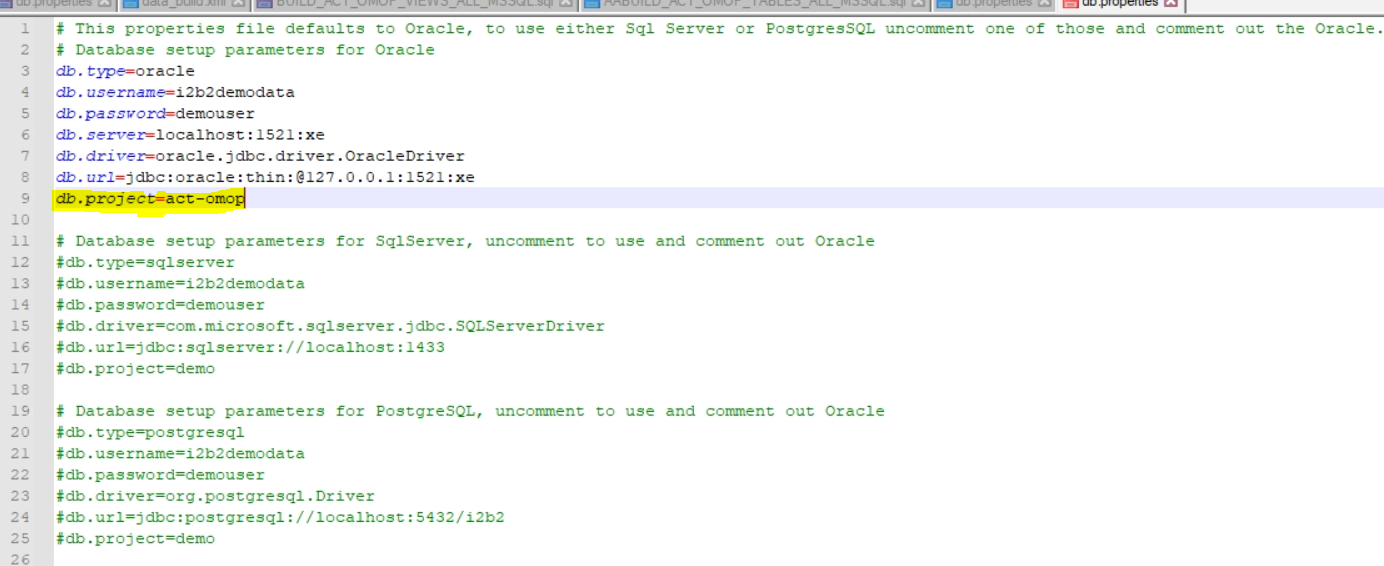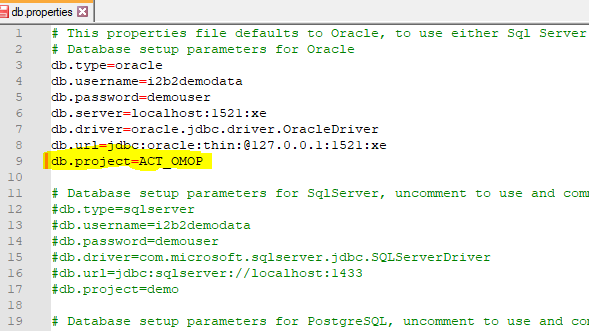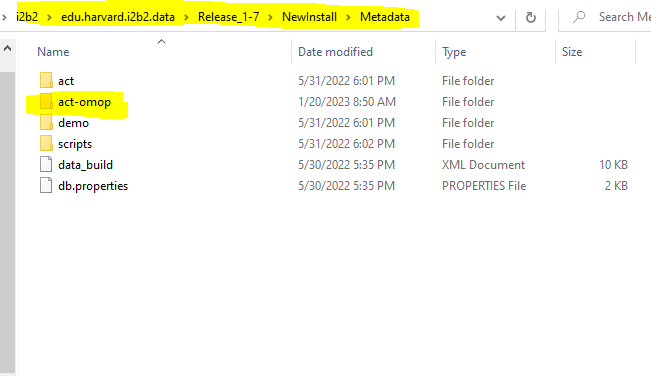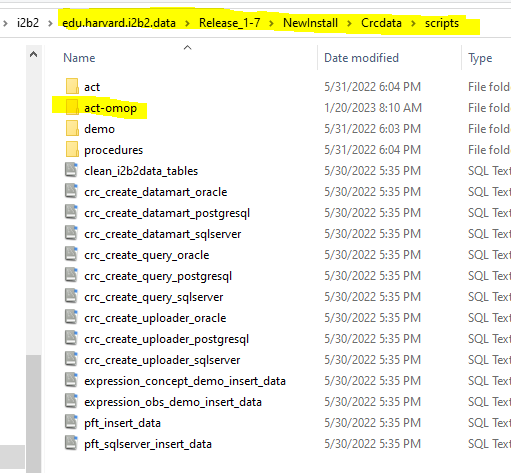Page History
PREVIEW VERSION AVAILABLE NOW. FINAL VERSION WILL BE
AVAILABLE MARCHRELEASED IN DECEMBER 2023.
Objective
Utilize the concept of a reusableDesign
Utilizing i2b2's reusable application programming interface (API) by using i2b2 API to adapt and support to support OMOP data model. Below steps involve creating datamodel-specific i2b2 ontologies and mapping these to query non-standard OMOP table structure
Steps to Create and Load ACT-OMOP Ontology
Step1: Create OMOP tables and load data using:
OMOPThe ACT-OMOP ontology queries OMOP table views that correspond to the OMOP table structure. On one database, the OMOP data and the i2b2 application layer are loaded. With the ontology, it becomes possible to query OMOP tables using the i2b2 interface. The design document can be found here.
Step 1: Acquire downloads
First, download the necessary components onto a computer that can connect to your target database and from which you can run SQL queries.
- Download i2b2.
- Download and extract the newinstall zip package from "Download Binary Distribution" in the top section of https://www.i2b2.org/software
- Determine if you need to install any additional required packages, such as Java JDK or Ant: Chapter 2. Requirements
- If running less than i2b2 1.8, separately download the latest data package from GitHub https://github.com/i2b2/i2b2-data to get the ACT-OMOP ontologies.
- OMOP 5.4 DDL SQL Scripts: https://github.com/OHDSI/CommonDataModel/tree/main/inst/ddl/5.4
- Either clone the repository or download the ETL scripts for your database platform.
Step 2: Create core tables and Views (OMOP, i2b2, and ACT-OMOP specific):
- OMOP: If you will be creating a new OMOP database for this installation, then:
- Run the OMOP 5.4 DDL SQL Scripts you downloaded in the last step, using a SQL client.
- It is recommended to run the DDL, indices, and primary key scripts, but NOT the constraints scripts.
It - Run the OMOP 5.4 DDL SQL Scripts you downloaded in the last step, using a SQL client.
- This can cause problems during ETL.
- ETL OMOP data
- This is a site-specific process, but OHDSI's WhiteRabbit tool can help: https://github.com/OHDSI/WhiteRabbit
Step 2: Create ACT-OMOP CRC and i2b2 core tables (e.g., QT and breakdowns)
- Download i2b2. (Download and extract the newinstall zip package from "Download Binary Distribution" in the top section of https://www.i2b2.org/software)
- If you have not installed i2b2 previously (i.e. you are not setting this up as an i2b2 Project in a larger installation):
- Make sure i2b2 is configured for multiple fact tables by changing the appropriate entry in the database.
- i2b2: Follow the instructions in Chapter 3 of the i2b2 installation guide to create the additional i2b2 tables needed for the application server: Chapter 3. Data Installation, these sections specifically:
- In 3.4.
- 2, edit the CRC db properties file
- to set db.project parameter to act-omop.
- Perform step 3.4.3-3.4.5 and drop/rename the PATIENT and VISIT_DIMENSION tables. E.g., run the commands:
- to set db.project parameter to act-omop.
ant -f data_build.xml create_crcdata_tables_release_1-7
FROM THE DATABASE: DROP PATIENT_DIMENSION; DROP VISIT_DIMENSION;
ant -f data_build.xml create_procedures_release_1-7
ant -f data_build.xml db_demodata_load_data
The final ant script will create act-omop Views, which point to the OMOP tables, and loads the concept_dimension table with act-omop concepts data, as well as creating the standard CRC tables and procedures.
| Info |
|---|
Be sure to drop/rename PATIENT_DIMENSION and VISIT_DIMENSION tables before you run the db_demodata_load_data ant target. |
Step 3: ACT-OMOP v4 ontology data load
and Views creationprocess
Both the- Follow the instructions in Chapter 3 of the i2b2 installation guide to create and load the ACT-OMOP
Navigate to the Metadata folder and execute below steps:
- metadata project.
- 3.7 Metadata Tables
- In 3.7.2, edit the Metadata db properties file. In db.properties, set db.project=ACT-OMOP parameter which will direct the ant script to load the ACT-OMOP ontology.
- In 3.7.4, only load the regular data, not the identified data. Run the ant command:
ant -f data_build.xml db_metadata_load_
data.data
- This will execute the SQL scripts from the edu.harvard.i2b2.data\Release_1-7\NewInstall\Metadata\act-omop\scripts\<db type> folder
- and:
- and:
- Creates ACT-OMOP v4 Ontology metadata tables with indexes.
- Loads the act-omop metadata
| Info |
|---|
The Lab metadata tables should have data in the C_METADATAXML column in order for the lab values to be queriable from UI If the C_METADATAXML is missing from the source ontology Lab metadata file, you can load the values from the standard i2b2-ACT Lab metadata table. |
Step 4: Create Project
Finally set up an i2b2 OMOP project pointing to the i2b2-OMOP database that you just configured.
6.6.0. [DRAFT] Guide to creating a new project with the admin tool.
Verify the Ontology is displayed and queriable from the webclient
Notes
Both the ACT-OMOP Ontology tables, views and data is available under edu.harvard.i2b2.data\Release_1-7\NewInstall\Metadata\act-omop folder.
The scripts are in this folder:
These are the ACT-OMOP ontology tables.
ACT_ICD10CM_DX_V4_OMOP ACT_ICD10PCS_PX_V4_OMOP ACT_ICD9CM_DX_V4_OMOP ACT_ICD9CM_PX_V4_OMOP ACT_CPT4_PX_V4_OMOP ACT_HCPCS_PX_V4_OMOP ACT_MED_ALPHA_V4_OMOP ACT_MED_VA_V4_OMOP ACT_MED_VA_V4_OMOP ACT_LOINC_LAB_PROV_V4_OMOP ACT_SDOH_V4_OMOP ACT_VITAL_SIGNS_V4_OMOP ACT_VISIT_DETAILS_V4_OMOP ACT_COVID_V4_OMOP ACT_DEM_V4_OMOP ACT_ICD10_ICD9_DX_V4_OMOP |
These are the ACT-OMOP views
by executing BUILD_ACT_OMOP_VIEWS_ALL_MSSQL.sql:
CONDITION_VIEW; DRUG_VIEW; MEASUREMENT_VIEW; OBSERVATION_VIEW; PROCEDURE_VIEW; COVID_LAB_VIEW; ALL_SOURCE_CONCEPTS; PATIENT_DIMENSION; VISIT_DIMENSION; DEVICE_VIEW; |
Step 4: Build ACT-OMOP CONCEPT DIMENSION
From the edu.harvard.i2b2.data\Release_1-7\NewInstall\CRC folder, run the ant command: ant -f data_build.xml db_demodata_load_data
This will execute the create_omop_act_concept_dimension SQL script from the edu.harvard.i2b2.data\Release_1-7\NewInstall\Crcdata\scripts\act-omop\<db type> folder and loads A concept dimension table
| Info |
|---|
The concept_Dimension is populated from metadata tables. Verify create_omop_act_concept_dimension.sql to ensure it has complete metadata tables information before running the script Example: the ACT/OMOPVital_Signs information should be in the script to load the ACT/OMOPVital_Signs concept data |
Step 5: Create Project
Finally set up an i2b2 OMOP project pointing to the i2b2-OMOP database that you just configured.
6.6.0. [DRAFT] Guide to creating a new project with the admin tool.
Verify the Ontology is displayed and queriable from the webclient
| Info |
|---|
The Lab metadata tables should have data in the C_METADATAXML column in order for the lab values to be queryable from UI If the C_METADATAXML is missing from the source ontology Lab metadata file, you can load the values from the standard i2b2-ACT Lab metadata table. |
- ETL OMOP data
- This is a site-specific process, but OHDSI's WhiteRabbit tool can help: https://github.com/OHDSI/WhiteRabbit




